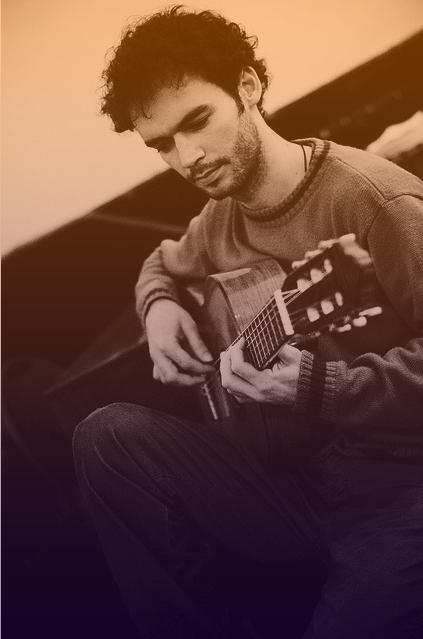May 15, 2019 by Klaus Crow
Photo by Janek Mann
 The one thing most beginners hate to practice is scales, because they don’t see the point of it. It takes some practice to learn scales properly and then it takes another while before you can use them as a tool for your playing. Patience is a virtue.
The one thing most beginners hate to practice is scales, because they don’t see the point of it. It takes some practice to learn scales properly and then it takes another while before you can use them as a tool for your playing. Patience is a virtue.
But once you master the major scales you can really unlock their full potential.
Scales are used for improvisation, analyzing chords, progressions, warming up, speed picking practice and much more. In other words just about everything that is important to become a good guitar player.
When the time is right you will recognize the importance and effectiveness of scale practice.
Today I wrote down 7 basic major scales for you to practice. One scale for every whole note. In music there are 7 whole notes. Whole notes are: A B C D E F G.
Most of the scales below are open major scales, which means they contain open string notes.
Play the scales using alternate picking (alternating up and down strokes ascending and descending).
While there are many other scales, the pentatonic scale and the major scale are the two most important scales to know. With these two scales you can already rule the world.
Study the major scales thoroughly. It’s good for you!
A MAJOR SCALE e:------------------------------2-4-5---------------| B:-----------------------2-3-5----------------------| G:----------------1-2-4-----------------------------| D:---------0-2-4------------------------------------| A:--0-2-4-------------------------------------------| E:--------------------------------------------------|B MAJOR SCALE e:------------------------------2-4-6-7-------------| B:----------------------2-4-5-----------------------| G:--------------1-3-4-------------------------------| D:-------1-2-4--------------------------------------| A:--2-4---------------------------------------------| E:--------------------------------------------------|C MAJOR SCALE e:----------------------------0-1-3-5-7-8-----------| B:---------------------1-3--------------------------| G:-------------0-2-4--------------------------------| D:-----0-2-3----------------------------------------| A:--3-----------------------------------------------| E:--------------------------------------------------|D MAJOR SCALE e:------------------------------2-3-5-7-9-10--------| B:----------------------2-3-5-----------------------| G:--------------0-2-4-------------------------------| D:-------0-2-4--------------------------------------| A:--------------------------------------------------| E:--------------------------------------------------|E MAJOR SCALE e:--------------------------------------0-----------| B:---------------------------------2-4--------------| G:-------------------------1-2-4--------------------| D:-----------------1-2-4----------------------------| A:---------0-2-4------------------------------------| E:--0-2-4-------------------------------------------|F MAJOR SCALE e:----------------------------------0-1-------------| B:-----------------------------1-3------------------| G:---------------------0-2-3------------------------| D:--------------0-2-3-------------------------------| A:-------0-1-3--------------------------------------| E:--1-3---------------------------------------------|G MAJOR SCALE e:------------------------------0-2-3---------------| B:-------------------------1-3----------------------| G:------------------0-2-4---------------------------| D:-----------0-2-4----------------------------------| A:----0-2-3-----------------------------------------| E:--3-----------------------------------------------|
Great tutorial Klaus, I have never been able to get my head around scales. I will try this over the next week to improve my playing.
Hey Ben,
Hang on. You’ll get there.
Good luck with http://www.Lickthatriff.com
Klaus Crow
Thank you for this tutorial, Klaus.
You are truly an inspiration.
Christopher
Hi Christopher.
Thanks for the nice comment.
If you have any questions about the subject let me know.
Best regards,
Klaus
hey man, i really appreciate the posts. been playing in minor keys for years now and i’m starting to do my majors homework now. Any chance on you posting a box style scale for each whole note? I tend to play in barre chords so ‘boxes’ or ‘blues boxes’ are really useful for me.
Hi Mitch,
Check out your inbox.
Best regards,
Klaus Crow
This helped me a lot, I have been learniing guitar for 4 years since I was 7 and our teacher recently introduced us to scales. At first I was completely bemused, but now I can understand them and thsi really helped me remember them!
very useful, especially for the beginners
Hello again! pls what are the numbers? are they the frets to be played on the different strings? Thanks for all ur posts.
Scarr – yes, the numbers are the frets. Scales are a great tool; at some point it’s as if your fingers just know the scales and your mind is free to do other things, such as develop riff patterns for improvising.
When I first learned guitar as a child (9-12), I found scales boring and pointless, and pretty much only did them under duress. Now that I’m relearning as an adult, however, I surprised myself with how useful I’m finding them to be — I know a fair amount about keys from playing other instruments and singing, so I started noodling around with scales just to have something not-too-demanding to play while I’m rebuilding my finger calluses, and they are *so* good for so many things. They give me something to build an exercise around when I want to working on picking skills, for instance, which would never have occurred to me when I was eleven, but I wish it had — it makes working on both skills more fun. I have a number of little mental games I like to play with them, like picking a random scale and a random string *not* to use, and playing the scale around that string, finding the notes I’d normally play on it elsewhere, which is great for learning the whole fretboard. If you find scales boring, work out how to play them in octaves (i.e., start a G scale on the low E 3rd fret and the open G string, played at the same time, then the open A string and the G string second fret, and so on) — finding the fingerings that you can do simultaneously can be tricky for some scales, and it’s a good fingerpicking exercise at the same time; you’ll definitely not find it dull.
very helpful one
Nice of u to display these lessons for a rookie like me
hi klaus sir,
your article is wonderful.I am interested in learning guitar because of you.your tips inspires me
Hi Klaus!
Awesome post.
BTW, which are to be learnt first, the pentatonic scales or the major scales?
Consider my skills a beginner since i want to learn to play the right way.
Thank you Klaus very very much for the very informative and useful knowlege you shared. It´s one of the best website I ever found. Please keep it going!!! :-)
is there a necessary hand placement for playing these scales?…thanks in advance…
I have been looking for this. I can read music already and now I am learning guitar at almost 60 and it is a lot of fun and there is satisfation. I hane learned the pesetonic and blue notes. Now for the majors the rest will come. Its great
Thx Dominic